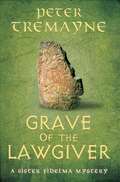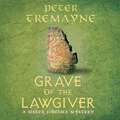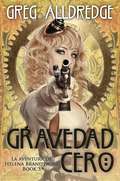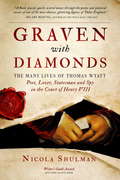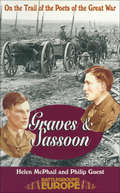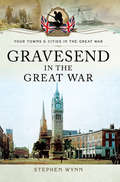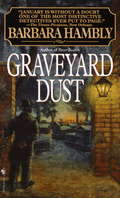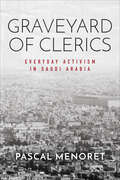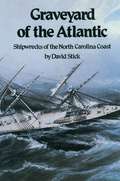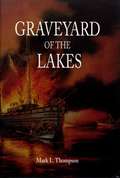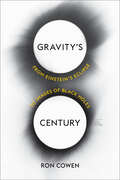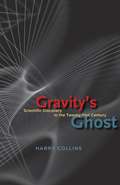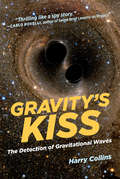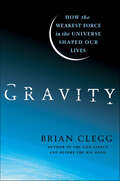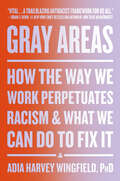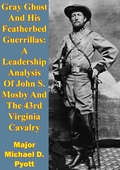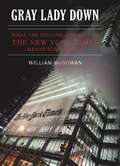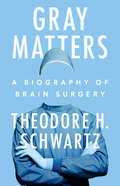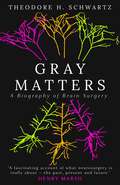- Table View
- List View
Grave of the Lawgiver: Sister Fidelma Mysteries Book 36
by Peter TremayneThe thirty-sixth mystery in Peter Tremayne's long-standing and much-loved series, featuring 7th-century Irish super-sleuth Sister Fidelma.The year is AD 673. Fidelma accompanies Eadulf to his hometown, Seaxmund's Ham in the Kingdom of the East Angles, to be greeted with the shocking news that Eadulf's uncle, Athelnoth, the lawgiver, has been murdered and his house burnt down. And Eadulf's younger sister is missing.The locals accuse Fidelma and Eadulf of the crimes, and Fidelma's safety is threatened by the first council of the bishops and kings of the Angles and Saxons, who wish to expel all Hibernian missionaries and teachers from the kingdoms.Against this opposition, Fidelma and Eadulf must unite to solve one of their most complex mysteries yet. Praise for the Sister Fidelma mysteries:'The background detail is brilliantly defined . . . wonderfully evocative' The Times'A challenging and unusual but deeply satisfying and enjoyable historical thriller' Booklist'Tremayne expertly incorporates historical and legal details of the time into the suspenseful plot. This impressive volume bodes well for future series entries' Publishers Weekly
Grave of the Lawgiver: Sister Fidelma Mysteries Book 36
by Peter TremayneThe thirty-sixth mystery in Peter Tremayne's long-standing and much-loved series, featuring 7th-century Irish super-sleuth Sister Fidelma.The year is AD 673. Fidelma accompanies Eadulf to his hometown, Seaxmund's Ham in the Kingdom of the East Angles, to be greeted with the shocking news that Eadulf's uncle, Athelnoth, the lawgiver, has been murdered and his house burnt down. And Eadulf's younger sister is missing.The locals accuse Fidelma and Eadulf of the crimes, and Fidelma's safety is threatened by the first council of the bishops and kings of the Angles and Saxons, who wish to expel all Hibernian missionaries and teachers from the kingdoms.Against this opposition, Fidelma and Eadulf must unite to solve one of their most complex mysteries yet. Praise for the Sister Fidelma mysteries:'The background detail is brilliantly defined . . . wonderfully evocative' The Times'A challenging and unusual but deeply satisfying and enjoyable historical thriller' Booklist'Tremayne expertly incorporates historical and legal details of the time into the suspenseful plot. This impressive volume bodes well for future series entries' Publishers Weekly
Gravedad Cero: Una aventura de Helena Brandywine. Libro 3 (Helena Brandywine #3)
by Greg AlldredgeHelena Brandywine ha descubierto la ubicación del último elemento necesario para completar el dirigible de Señor Mago. Sin embargo, el Conde Stroganov y sus secuaces están cerca, esperando tener en sus manos los secretos del barco. Necesita desesperadamente terminar el dirigible para poder escapar de la ciudad y las acusaciones de ser una peligrosa bruja asesina. Si no se marcha; San Francisco ha planeado una estadía prolongada en el manicomio local. Un hombre misterioso la persigue, un dragón antiguo le está enseñando y un nuevo mal ha entrado en el mundo desde su cama. ¿Qué puede salir bien? No te pierdas Gravedad Cero, la tercera entrega de la serie Brandywine de Greg Alldredge. Si te gusta la aventura y la fantasía con una fuerte protagonista femenina, ¡esta novela Steampunk para jóvenes adultos te hará pasar las páginas! ¡Ven a verlo!
Gravelotte-St-Privat 1870
by Philipp Elliot-WrightGravelotte-St-Privat was probably the hardest fought of all the battles of the Franco-Prussian War (1870-1871). Attacked by superior Prussian forces from both the First and Second armies, Marshal Bazaine's French Army of the Rhine inflicted heavy casualties on the advancing Prussian's before finally being forced to retreat into the fortress city of Metz. Unable to break out and with no hope of relief Bazaine's army grimly held on to the end of the war. French failure at Gravelotte-St-Privat led directly to their final defeat at Sedan, the collapse of Napoleon III's regime and the proclamation of the German Empire.
Graven With Diamonds
by Nicola ShulmanIn this thrillingly entertaining book, Nicola Shulman interweaves the bloody events of Henry VIII's reign with the story of English love poetry and the life of its first master, Henry VIII's most glamorous and enigmatic subject: Sir Thomas Wyatt. Poet, statesman, spy, lover of Anne Boleyn and favorite both of Henry VIII and his sinister minister Thomas Cromwell, the brilliant Wyatt was admired and envied in equal measure. His love poetry began as risqué entertainment for ambitious men and women at the slippery top of the court. But when the axe began to fall and Henry VIII's laws made his subjects fall silent in terror, Wyatt's poetic skills became a way to survive. He saw that a love poem was a place where secrets could hide.
Graves & Sassoon: On the Trail of the Poets of the Great War (Battleground Europe)
by Helen McPhail Philip GuestThe war memoirs of these two officers with the Royal Welsh Fusiliers have never been out of print since their first publication. Both men won instant and enduring fame with these very different narratives, which made them two of the most influential participants in shaping later attitudes to the war. Graves gave offence in many quarters with his factual inaccuracies and/or slurs on various units of the British Army. Sassoon's nostalgic evocation of his cricketing and fox-hunting background contrast with the detailed narrative of personalities and life in the Battle of the Somme and the Battle of Arras. The thinly disguised names of real fellow officers are unravelled to help illustrate Sassoon's poetry and actions.
Graves of His Personal Liking
by Joel JurrensBen Cone has a simple dream: get enough gold to marry Madeline and take her to Boston where they will live happily ever after. But his quest to the Black Hills for gold soon turns into a trail of graves. Partnered up with an ancient buffalo hunter and his feisty granddaughter, Ben will spend a long bitter winter with the Cheyenne, run from warring Indians, fight outlaws and dig graves for friends and enemies. Forced to choose between a new love and an old one, Ben will have to decide if the price of a dream can be too much to continue pursuing it, or if you can sacrifice so much for a dream that you can never give it up.
Gravesend in the Great War (Your Towns & Cities in the Great War)
by Stephen WynnGravesend was like most other towns in the UK during the course of the First World War. When the call came to serve King and Country, local men enlisted in their thousands, but sadly not all of them returned.This book gives an insight into the Tilbury to Gravesend Pontoon Bridge, which allowed the rapid deployment of troops in the event of a German invasion along the East Coast. It provided a quicker route to get troops, equipment and supplies from Essex into Kent for transportation across to France. It looks at the role both New Tavern and Shornemead Fort, part of the London Defence system, played in preventing the German Navy from carrying out direct attacks on London.There is an account of the Gravesend riots, in which groups of local people burnt and looted premises they believed belonged to German aliens who were residents in the town, and the unique story of Captain Robert Campbell, taken as a prisoner by the Germans early in the war. He was allowed home by the Kaiser to see his dying mother one last time, and voluntarily returned to captivity in Germany, on his word of honour to do so.The story of Sir Gilbert Parker, the wartime MP for Gravesend, is also told. He was instrumental in convincing America to join the war as a British Allie, which was no easy task, as the United States Justice Department estimated there were some 480,000 Germans living in America at the time.The book also tells the individual stories of Gravesend's men who fought in the war, some who survived and returned to their loved ones, and others who were not so fortunate. It documents the triumphs and tragedies of Gravesend's people as they sought to find normality amongst a reality far removed from anything they had ever known before.
Gravesend, Brooklyn (Then and Now)
by Joseph DittaPermanently settled in 1645, the farming town of Gravesend, Long Island, was annexed to the city (now borough) of Brooklyn, New York, in 1894. Few reminders from Gravesend's rural days survive around the urban landscape it has become. Even its more recent past is quickly disappearing.
Graveyard Dust (Benjamin January #3)
by Barbara HamblyBestselling author Barbara Hambly'sA Free Man of ColorandFever Seasonestablished Benjamin January as one of mystery's most exciting heroes. Now he returns in a powerful new novel, a sensual mosaic of old New Orleans, where cultures clash and murder can hover around every darkened corner. . . . It is St. John's Eve in the summer of 1834 when Benjamin January--Creole physician and music teacher--is shattered by the news that his sister has been arrested for murder. The Guards have only a shadow of a case against her. But Olympe--mystical and rebellious--is a woman of color, whose chance for justice is slim. As Benjamin probes the allegation, he is targeted by a new threat: graveyard dust sprinkled at his door, whispering of a voodoo death curse. Now, to save Olympe's life--and his own--Benjamin knows he must glean information wherever he can find it. For in the heavy darkness of New Orleans, the truth is what you make it, and justice can disappear with the night's warm breeze as easy as graveyard dust. . . .
Graveyard Poetry: Religion, Aesthetics and the Mid-Eighteenth-Century Poetic Condition (British Literature in Context in the Long Eighteenth Century)
by Eric ParisotWhile immensely popular in the eighteenth century, current critical wisdom regards graveyard poetry as a short-lived fad with little lasting merit. In the first book-length study of this important poetic mode, Eric Parisot suggests, to the contrary, that graveyard poetry is closely connected to the mid-century aesthetic revision of poetics. Graveyard poetry's contribution to this paradigm shift, Parisot argues, stems from changing religious practices and their increasing reliance on printed material to facilitate private devotion by way of affective and subjective response. Coupling this perspective with graveyard poetry’s obsessive preoccupation with death and salvation makes visible its importance as an articulation or negotiation between contemporary religious concerns and emerging aesthetics of poetic practice. Parisot reads the poetry of Robert Blair, Edward Young and Thomas Gray, among others, as a series of poetic experiments that attempt to accommodate changing religious and reading practices and translate religious concerns into parallel reconsiderations of poetic authority, agency, death and afterlife. Making use of an impressive body of religious treatises, sermons and verse that ground his study in a precise historical moment, Parisot shows graveyard poetry's strong ties to seventeenth-century devotional texts, and most importantly, its influential role in the development of late eighteenth-century sentimentalism and Romanticism.
Graveyard of Clerics: Everyday Activism in Saudi Arabia (Stanford Studies in Middle Eastern and Islamic Societies and Cultures)
by Pascal MenoretThe inside story of political protest in Saudi Arabia—on the ground, in the suburbs, and in the face of increasing state repression. Graveyard of Clerics takes up two global phenomena intimately linked in Saudi Arabia: urban sprawl and religious activism. Saudi suburbia emerged after World War II as citizens fled crowded inner cities. Developed to encourage a society of docile, isolated citizens, suburbs instead opened new spaces for political action. Religious activists in particular turned homes, schools, mosques, and summer camps into resources for mobilization. With the support of suburban grassroots networks, activists won local elections and found opportunities to protest government actions—until they faced a new wave of repression under the current Saudi leadership. Pascal Menoret spent four years in Saudi Arabia in the places where today's Islamic activism first emerged. With this book, he tells the stories of the people actively countering the Saudi state and highlights how people can organize and protest even amid increasingly intense police repression. This book changes the way we look at religious activism in Saudi Arabia. It also offers a cautionary tale: the ongoing repression by Saudi elites—achieved often with the complicity of the international community—is shutting down grassroots political movements with significant consequences for the country and the world.
Graveyard of the Atlantic
by David StickThis is a factual account, written in the pace of fiction, of hundreds of dramatic losses, heroic rescues, and violent adventures at the stormy meeting place of northern and southern winds and waters -- the Graveyard of the Atlantic off the Outer Banks of North Carolina.
Graveyard of the Lakes
by Mark L. ThompsonFor the first time, a historian and seasoned mariner looks beyond the specific circumstances of individual shipwrecks in an effort to reach a clearer understanding of the economic, political, and psychological factors that have influenced the 25,000 wrecks on the Great Lakes over the past 300 years. Looking at the entire tragic history of shipwrecks on North America's expansive inland seas, from the 1679 loss of the Griffon to the mysterious sinking of the Edmund Fitzgerald in 1975, Mark L. Thompson concludes that a wreck is not an isolated event. In Graveyard of the Lakes, Thompson suggests that most of the accidents and deaths on the lakes have been the result of human error, ranging from simple mistakes to gross incompetence. In addition to his compelling analysis of the causes of shipwrecks, Thompson includes factual accounts of more than one hundred wrecks. Graveyard of the Lakes will forever change the reader's perspective on shipwrecks.
Gravity
by George GamowA distinguished physicist and teacher, George Gamow also possessed a special gift for making the intricacies of science accessible to a wide audience. In Gravity, he takes an enlightening look at three of the towering figures of science who unlocked many of the mysteries behind the laws of physics: Galileo, the first to take a close look at the process of free and restricted fall; Newton, originator of the concept of gravity as a universal force; and Einstein, who proposed that gravity is no more than the curvature of the four-dimensional space-time continuum.Graced with the author's own drawings, both technical and fanciful, this remarkably reader-friendly book focuses particularly on Newton, who developed the mathematical system known today as the differential and integral calculus. Readers averse to equations can skip the discussion of the elementary principles of calculus and still achieve a highly satisfactory grasp of a fascinating subject.Starting with a chapter on Galileo's pioneering work, this volume devotes six chapters to Newton's ideas and other subsequent developments and one chapter to Einstein, with a concluding chapter on post-Einsteinian speculations concerning the relationship between gravity and other physical phenomena, such as electromagnetic fields.
Gravity's Century: From Einstein's Eclipse to Images of Black Holes
by Ron Cowen&“This gracefully written history of twentieth-century gravity research&” brings to life the discoveries and developments that confirmed the theory of relativity (Publishers Weekly, starred review). Albert Einstein did nothing of note on May 29, 1919, yet that is when he became immortal. On that day, astronomer Arthur Eddington and his team observed a solar eclipse and found something extraordinary: gravity bends light, just as Einstein predicted. The finding confirmed the theory of general relativity, fundamentally changing our understanding of space and time. A century later, the Event Horizon Telescope examined the space surrounding Sagittarius A*, the supermassive black hole at the center of the Milky Way, to determine whether Einstein was right on the details. In Gravity&’s Century, award-winning science writer Ron Cowen brings to life the incredible scientific journey between these two events and sheds light on their groundbreaking implications. From the development of radio telescopes to the discovery of black holes and quasars, and the still-unresolved place of gravity in quantum theory, Cowen breaks down the physics in clear and approachable language. Gravity&’s Century vividly demonstrates how the quest to understand gravity is really the quest to comprehend the universe.
Gravity's Ghost: Scientific Discovery in the Twenty-first Century
by Harry CollinsA gripping look at gravitational wave research and what it says about scientific discovery and the future of the scientific community.&“This fine book pairs exploratory analysis with the pulse of a detective story. Giving a portrait of the way a community chose to test itself on the threshold of new knowledge, Collins offers the rich sociological insight that can only be won from uncommon experience, from a long-standing dialogue with the community he studies, and from a moral engagement in the future of science.&” —Richard Staley, author of Einstein&’s Generation: The Origins of the Relativity Revolution In theory, at least, gravitational waves do exist. We are constantly bathed in gravitational radiation, which is generated when stars explode or collide and a portion of their mass becomes energy that ripples out like a disturbance on the surface of a serene pond. But unfortunately no gravitational wave has ever been directly detected even though the search has lasted more than forty years. As the leading chronicler of the search for gravitational waves, Harry Collins has been right there with the scientists since the start. The result of his unprecedented access to the front lines of physical science is Gravity&’s Ghost, a thrilling chronicle of high-stakes research and cutting-edge discovery. Here, Collins reveals that scientific discovery and nondiscovery can turn on scientific traditions and rivalries, that ideal statistical analysis rests on impossible procedures and unattainable knowledge, and that fact in one place is baseless assumption in another. He also argues that sciences like gravitational wave detection, in exemplifying how the intractable is to be handled, can offer scientific leadership a moral beacon for the twenty-first century. In the end, Gravity&’s Ghost shows that discoveries are the denouements of dramatic scientific mysteries. &“A sociologist embedded (with full access!) in the LIGO Scientific Collaboration chronicles the search for gravitational waves. Though physicists, with very few exceptions, are in no doubt that gravitational waves exist, evidence for their passage through the new kilometer-length interferometers would nevertheless represent the scientific event of the twenty-first century. Harry Collins has turned the initial joined search exploiting the LIGO and Virgo instruments into a detective novel that exquisitely describes the social processes associated with discovery (and statistical analysis) in a large collaborative effort.&”—Francis Halzen, University of Wisconsin–Madison and Director of Icecube Neutrino Detector Project
Gravity's Kiss: The Detection of Gravitational Waves (The\mit Press Ser.)
by Harry CollinsA fascinating account, written in real time, of the unfolding of a scientific discovery: the first detection of gravitational waves.Scientists have been trying to confirm the existence of gravitational waves for fifty years. Then, in September 2015, came a “very interesting event” (as the cautious subject line in a physicist's email read) that proved to be the first detection of gravitational waves. In Gravity's Kiss, Harry Collins—who has been watching the science of gravitational wave detection for forty-three of those fifty years and has written three previous books about it—offers a final, fascinating account, written in real time, of the unfolding of one of the most remarkable scientific discoveries ever made. Predicted by Einstein in his theory of general relativity, gravitational waves carry energy from the collision or explosion of stars. Dying binary stars, for example, rotate faster and faster around each other until they merge, emitting a burst of gravitational waves. It is only with the development of extraordinarily sensitive, highly sophisticated detectors that physicists can now confirm Einstein's prediction. This is the story that Collins tells.Collins, a sociologist of science who has been embedded in the gravitational wave community since 1972, traces the detection, the analysis, the confirmation, and the public presentation and the reception of the discovery—from the first email to the final published paper and the response of professionals and the public. Collins shows that science today is collaborative, far-flung (with the physical location of the participants hardly mattering), and sometimes secretive, but still one of the few institutions that has integrity built into it.
Gravity: How the Weakest Force in the Universe Shaped Our Lives
by Brian CleggA history of gravity, and a study of its importance and relevance to our lives, as well as its influence on other areas of science.Physicists will tell you that four forces control the universe. Of these, gravity may be the most obvious, but it is also the most mysterious. Newton managed to predict the force of gravity but couldn’t explain how it worked at a distance. Einstein picked up on the simple premise that gravity and acceleration are interchangeable to devise his mind-bending general relativity, showing how matter warps space and time. Not only did this explain how gravity worked—and how apparently simple gravitation has four separate components—but it predicted everything from black holes to gravity’s effect on time. Whether it’s the reality of anti-gravity or the unexpected discovery that a ball and a laser beam drop at the same rate, gravity is the force that fascinates.
Gravity’s Century: From Einstein’s Eclipse to Images of Black Holes
by Ron CowenRon Cowen offers a sweeping account of the century of experimentation that has consistently confirmed Einstein’s general theory of relativity. He shows how we got from Eddington’s pivotal observations of the 1919 eclipse to the Event Horizon Telescope, aimed at starlight wrapping around the black hole at our galaxy’s center.
Gray Areas: How the Way We Work Perpetuates Racism and What We Can Do to Fix It
by Adia Harvey WingfieldGray Areas has descriptive copy which is not yet available from the Publisher.
Gray Ghost And His Featherbed Guerrillas: A Leadership Analysis Of John S. Mosby And The 43rd Virginia Cavalry
by Major Michael D. PyottJohn Singleton Mosby led a successful partisan campaign during the American Civil War for the Confederacy. Prior to the war, Mosby was a frail nondescript lawyer. Entering the war as a private; Mosby eventually rose to the rank of Colonel. He organized, trained, and equipped the 43rd Virginia Cavalry, better known as Mosby's Rangers. This unit grew from nine men to almost nine hundred at the war's end, and conducted many daring celebrated raids on the Union forces and their supply lines. In addition to his raids Mosby provided accurate and timely intelligence to Major General J. E. B. Stuart and General Robert E. Lee throughout his service. This study is a leadership analysis of John Singleton Mosby using the U.S. Army's Field Manual 22-1 00, Army Leadership. The study examines Mosby's leadership development and evaluates him against the sixteen leadership dimensions that the Army currently uses to evaluate potential officers. The purpose of this study is to determine what leadership qualities Mosby possessed that contributed to his success. The study concludes that Mosby was able to influence subordinates, peers, superiors, and non-combatants; he provided a purpose and gave them direction and motivation; he also continuously sought ways to improve and expand the organization.
Gray Lady Down
by William McgowanThe New York Times was once considered the gold standard in American journalism and the most trusted news organization in America. Today, it is generally understood to be a vehicle for politically correct ideologies, tattered liberal pieties, and a repeated victim of journalistic scandal and institutional embarrassment.In Gray Lady Down, the hard-hitting follow up to Coloring the News, William McGowan asks who is responsible for squandering the finest legacy in American journalism. Combining original reporting, critical assessment and analysis, McGowan exposes the Times' obsessions with diversity, "soft" pop cultural news, and countercultural Vietnam-era attitudinizing, and reveals how these trends have set America's most important news icon at odds with its journalistic mission-and with the values and perspectives of much of mainstream America.Gray Lady Down considers the consequences-for the Times, for the media, and, most important, for American society and its political processes at this fraught moment in our nation's history. In this highly volatile media environment, the fate of the Times may portend the future of the fourth estate.
Gray Matters: A Biography of Brain Surgery
by Theodore H. Schwartz&“If you are at all curious about the brain or the surgeons who operate on it, Gray Matters is a must read and Dr. Theodore Schwartz is the perfect guide, a master brain surgeon and superbly talented writer. I have not read a better biography of our shared profession, and in Schwartz's talented hands, the most enigmatic 3 1/2 pounds of tissue in the known universe comes to light in remarkable and revelatory ways.&”—Dr. Sanjay Gupta, CNN Chief Medical Correspondent, and New York Times and #1 Wall Street Journal bestselling author of Keep Sharp: Build a Better Brain at Any AgeA popular biography of brain surgery, by one of its preeminent practitionersWe&’ve all heard the phrase &“it&’s not brain surgery.&” But what exactly is brain surgery? It&’s a profession that is barely a hundred years old and profoundly connects two human beings, but few know how it works, or its history. How did early neurosurgeons come to understand the human brain—an extraordinarily complex organ that controls everything we do, and yet at only three pounds is so fragile? And how did this incredibly challenging and lifesaving specialty emerge? In this warm, rigorous, and deeply insightful book, Dr. Theodore H. Schwartz explores what it&’s like to hold the scalpel, wield the drill, extract a tumor, fix a bullet hole, and remove a blood clot—when every second can mean life or death. Drawing from the author&’s own cases, plus media, sports, and government archives, this seminal work delves into all the brain-related topics that have long-consumed public curiosity, like what really happened to JFK, President Biden&’s brain surgery, and the NFL&’s management of CTE. Dr. Schwartz also surveys the field&’s latest incredible advances and discusses the philosophical questions of the unity of the self and the existence of free will. A neurosurgeon as well as a professor of neurosurgery at Weill Cornell Medicine, one of the busiest and most highly ranked neurosurgery centers in the world, Dr. Schwartz tells this story like no one else could. Told through anecdote and clear explanation, this is the ultimate cultural and scientific history of a literally mind-blowing human endeavor, one that cuts to the core of who we are.
Gray Matters: A Biography of Brain Surgery
by Theodore Schwartz&‘A fascinating and wide-ranging account of what neurosurgery is really about – the past, present and future.&’ Henry Marsh, author of Do No Harm Since its inception in the early twentieth century, brain surgery has maintained an air of mystery. As the saying &‘it&’s not exactly brain surgery&’ suggests, the specialty has become synonymous with a level of complexity and meticulousness rivalled only by, well, rocket science. Warm, rigorous and deeply insightful, neurosurgeon Theodore Schwartz reveals what it&’s really like to get inside someone&’s head – where every second can mean the difference between life or death. Drawing from Schwartz&’s experience in one of New York&’s busiest hospitals, Gray Matters explores the short but storied history of brain surgery. From the dark days of the lobotomy to the latest research into the long-term effects of contact sports on athletes&’ cerebral health, Schwartz unfolds the fascinating story of how we came to understand this extraordinary, three-pound organ, which not only keeps us alive, but makes us who we are.
